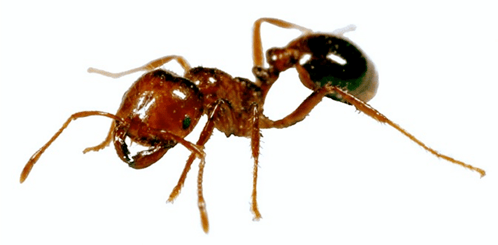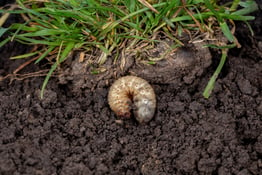A Closer Look with Heather Patterson

Red Imported Fire Ants are a non-native, mound-building ant species that has become established in many U.S. states, particularly in the southeast. Workers within the fire ant colony vary in size, and will aggressively defend their nests from threat or disturbance. As for coloration, these ants will usually have reddish to brown heads and bodies that transition to darker, almost black gasters (abdomens). Another identifying feature (if you choose to examine closely) will be the two nodes, or bumps, located on their thin waist just before the large gaster.
Are they commonly confused with other ants, and if so, what are the differentiators?
- It’s not uncommon for fire ants and their mounds to be confused with or misidentified as another ant species, such as leafcutter, harvester, or pyramid ants. Since there are a only few common mound-building ants encountered in the landscape, observing if the mound has a central entrance hole or not will help you determine which type of ant it may belong to. Fire ant mounds lack that central entrance hole, whereas mounds from harvester, pyramid, and leafcutter ants have it. Additionally, harvester and leafcutter ants are much larger, and pyramid ants have that characteristic pyramid shape on the top of their thorax.
Is there a certain time of year to treat for fire ants? If so, when?
- When it comes to controlling fire ants, the spring and fall are good times to apply bait products. In mid- to late-spring when temperatures warm, mounds start to pop up and fire ants get to work. Workers head out to actively forage, and will gather food and bait granules to bring back to their nestmates. Bait applications in the fall are effective for targeting these fire ant colonies when they are in decline, helping to reduce the population and mounds that will be observed the following spring.
How should professionals treat for/control fire ants (ex. chemicals/modes of action to use, cultural practices, etc.)?
- The good news is that landscape professionals have access to a variety of effective formulations and product solutions for fire ants. Granular insecticides, liquid concentrates, and baits granules are all important tools for ant management, and the speed and length of control can depend on the product you choose. If curative action and quick results are needed, especially in places with high foot traffic, a contact insecticide spray product is a good option to consider. Targeting mounds with products that can be used for mound drenching, like Bifen I/T, is also an effective approach for fire ant control.
Are there mistakes to avoid or things not to do when treating fire ants?
- If ants are up against a foundation wall or next to a structure, it’s not recommend to use a product with repellent chemistries that could potentially drive them into the structure. Products like baits or liquid concentrates with non-repellent chemistries should be considered for controlling such colonies. Remember: it’s critical to read and follow all label directions. Applicators need to know if the intended site for application is allowed, what PPE is required, and how to properly apply to product. If using an granular insecticide for fire ants, it’s important that the applicator determine if the label requires the product to be watered in.
Is there anything else lawn care professionals should know or do to control fire ants?
- Fire ants thrive in disturbed habitats, including yards, gardens, alongside curbs or sidewalks, and in grassy areas. Remember the tip for fall bait applications. Getting a head start on suppressing next year’s fire ant numbers can offer a huge benefit to that season’s fireant management program.




